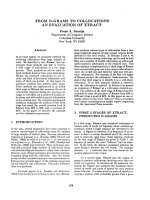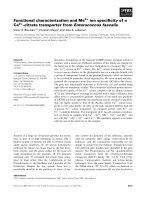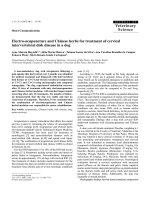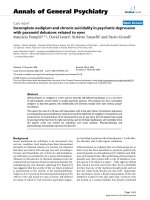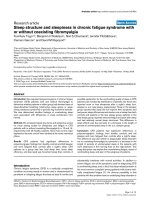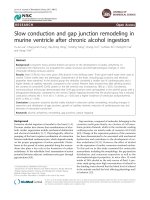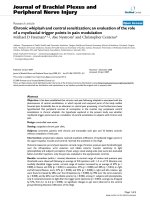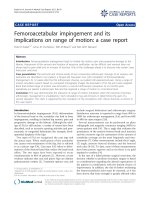Báo cáo y học: "Chronic whiplash and central sensitization; an evaluation of the role of a myofascial trigger points in pain modulation" docx
Bạn đang xem bản rút gọn của tài liệu. Xem và tải ngay bản đầy đủ của tài liệu tại đây (258.58 KB, 8 trang )
BioMed Central
Page 1 of 8
(page number not for citation purposes)
Journal of Brachial Plexus and
Peripheral Nerve Injury
Open Access
Research article
Chronic whiplash and central sensitization; an evaluation of the role
of a myofascial trigger points in pain modulation
Michael D Freeman*
1,2
, Ake Nystrom
3
and Christopher Centeno
4
Address:
1
Department of Public Health and Preventive Medicine, Oregon Health and Science University School of Medicine, Portland, Oregon,
USA,
2
Institute of Forensic Medicine, Faculty of Health Sciences, University of Aarhus, Aarhus, Denmark,
3
University of Nebraska Medical Center,
Omaha, Nebraska, USA and
4
Spinal Injury Foundation, Westminster, Colorado, USA
Email: Michael D Freeman* - ; Ake Nystrom - ;
Christopher Centeno -
* Corresponding author
Abstract
Objective: it has been established that chronic neck pain following whiplash is associated with the
phenomenon of central sensitization, in which injured and uninjured parts of the body exhibit
lowered pain thresholds due to an alteration in central pain processing. it has furthermore been
hypothesized that peripheral sources of nociception in the muscles may perpetuate central
sensitization in chronic whiplash. the hypothesis explored in the present study was whether
myofascial trigger points serve as a modulator of central sensitization in subjects with chronic neck
pain.
Design: controlled case series.
Setting: outpatient chronic pain clinic.
Subjects: seventeen patients with chronic and intractable neck pain and 10 healthy controls
without complaints of neck pain.
Intervention: symptomatic subjects received anesthetic infiltration of myofascial trigger points in
the upper trapezius muscles and controls received the anesthetic in the thigh.
Outcome measures: pre and post injection cervical range of motion, pressure pain thresholds (ppt)
over the infraspinatus, wrist extensor, and tibialis anterior muscles. sensitivity to light
(photophobia) and subjects' perception of pain using a visual analog scale (vas) were also evaluated
before and after injections. only the ppt was evaluated in the asymptomatic controls.
Results: immediate (within 1 minute) alterations in cervical range of motion and pressure pain
thresholds were observed following an average of 3.8 injections with 1–2 cc of 1% lidocaine into
carefully identified trigger points. cervical range of motion increased by an average of 49% (p =
0.000) in flexion and 44% (p = 0.001) in extension, 47% (p = 0.000) and 28% (p < 0.016) in right
and left lateral flexion, and a 27% (p = 0.002) and 45% (p = 0.000) in right and left rotation. ppt
were found increased by 68% over the infraspinatus (p = 0.000), by 78% over the wrist extensors
(p = 0.000), and by 64% over the tibialis anterior (p = 0.002). among 11 subjects with photophobia,
only 2 remained sensitive to light after the trigger point injections (p = 0.033). average vas dropped
by 57%, from 6.1 to 2.6 (p = 0.000). no significant changes in ppt were observed in the control
group following lidocaine infiltration of the thigh.
Published: 23 April 2009
Journal of Brachial Plexus and Peripheral Nerve Injury 2009, 4:2 doi:10.1186/1749-7221-4-2
Received: 1 December 2008
Accepted: 23 April 2009
This article is available from: />© 2009 Freeman et al; licensee BioMed Central Ltd.
This is an Open Access article distributed under the terms of the Creative Commons Attribution License ( />),
which permits unrestricted use, distribution, and reproduction in any medium, provided the original work is properly cited.
Journal of Brachial Plexus and Peripheral Nerve Injury 2009, 4:2 />Page 2 of 8
(page number not for citation purposes)
Conclusion: the present data suggest that myofascial trigger points serve to perpetuate lowered
pain thresholds in uninjured tissues. additionally, it appears that lowered pain thresholds associated
with central sensitization can be immediately reversed, even when associated with long standing
chronic neck pain. although the effects resulting from anesthesia of trigger points in the present
study were temporary, it is possible that surgical excision or ablation of the same trigger points
may offer more permanent solutions for chronic neck pain patients. further study is needed to
evaluate these and other options for such patients.
Introduction
Chronic pain from injury, including injury from whiplash
trauma, is associated with centrally mediated hyperalge-
sia, also known as central sensitization. [1] Several
authors have described lowered pain thresholds in unin-
jured tissues, and explained the finding as the expression
of an abnormal processing of nociceptive information in
the brain and spinal cord. [2-7] Others have postulated
that chronicposttraumatic myalgia (muscle pains) may-
perpetuateandaccentuate thepain status of afflicted
patients, [8,9] and Ge et al. recently reported experimental
evidence of a physiologic link between myofascial trigger
points and central sensitization in patients with shoulder
pain of myofascial origin. [10] In contrast, Curatolo et al,
in a study of chronic whiplash patients, reported that
anesthetic infiltration of painful or tender points did not
alter the signs of central sensitization. [11] An explanation
for this discrepancy may lie in the definition of what con-
stitutes a myofascial pain generator. While both 'tender
points' and myofascial trigger points are painful to palpa-
tion, only myofascial trigger points will fasciculate or
"twitch" when probed with a needle. [12] The presence of
a twitch response to needle probing has been experimen-
tally demonstrated as a necessary prerequisite for trigger
point deactivation and pain relief with local anesthetic
injection. [13] Based on these previously reported find-
ings, it is reasonable to hypothesize that anesthetization
of carefully identified trigger points may alter findings of
central sensitization in patients with chronic neck pain.
In the present study the authors set out to evaluate
whether anesthetic infiltration of myofascial trigger points
in patients with chronic and refractory neck pain can
affect pain thresholds in uninjured parts of the body.
Methods
Seventeen participants were recruited from a group of
twenty-threepatients who were referred for surgical evalu-
ation for chronic and refractory neck pain. Inclusion crite-
ria were as follows:
1. Male or female, 19–65 years of age.
2. Intrusive daily neck pain for at least 12 months.
3. Failure of conservative therapies, e.g. physical therapy,
chiropractic manipulation, or acupuncture.
Exclusion criteria included signs or symptoms of radicu-
lopathy or myelopathy, or radiographic evidence of signif-
icant spine pathology.
Institutional Review Board oversight and approval was
provided by the Spinal Injury Foundation in Westminster,
Colorado.
Pre-intervention evaluations
1. Cervical range of motion (CROM) in flexion, extension,
right and left lateral flexion, and right and left rotation
was determined with inclinometry. This evaluation was
only performed on the study subjects and not the controls
and the subjects were blinded as to the results.
2. Pressure pain thresholds (PPT) were determined on one
side of the body using algometry as described by Koel-
baek-Johansen et al. [2] Laterality was determined accord-
ing to subjects' indication of the side with the most
intense symptoms. Left was chosen as the default side ifa
patient could not differentiate one side as more sympto-
matic then the other. The calibrated algometer had a range
of 0.5 – 25 lbs (1.1–13.4 kg) distributed over a 1 cm cir-
cular tip. Test sites were in three different muscles: infra-
spinatus – 3 cm inferior to the scapular spine and 3 cm
lateral to the medial scapular border; wrist extensor – 5 cm
distal to the lateral epicondyle with forearm in full supi-
nation; tibialis anterior – 5 cm distal to the tibial tuberos-
ity, and 2 cm lateral to the anterior tibial margin. Pain
thresholds were determined by slowly and gradually
increasing the pressure of the algometer tip against the
marked test site. Identical protocols were used to assess
pain thresholds in the study group and the control group,
and all subjects were blinded with to the values recorded
from each test.
3. Presence or absence of photophobia was determined by
shining light from an ophthalmoscope into the ipsilateral
eye for 3 seconds. Photophobia was considered present if
the subject confirmed immediate onset or worsening of
periocular pain or headaches. This evaluation was only
performed on the study subjects.
Journal of Brachial Plexus and Peripheral Nerve Injury 2009, 4:2 />Page 3 of 8
(page number not for citation purposes)
4. Subjective assessment of neck painwas madeusing a vis-
ual analogue scale (VAS) graded 0–10. This evaluation
was only performed on the study subjects.
Intervention
One examiner performed all interventions. Myofascial
trigger points (TP) were mapped through palpation
alongthe upper trapezius, and traced on the skin with a
permanent marker. Next, the focal pain generator within
each trigger point was identified through probing witha
25 gauge needleforsharp pain and a twitchresponse, and
injected with 1–2 cc 1% lidocaine (10–20 mg). The proce-
dure was repeated at other previously identified and
marked TPs until the subject indicated a significant relief
of neck pain. Aminimum of one, but never more than
eight trigger points were injected in any of the subjects,
and no single TP was injected more than once. The total
amount of 1% lidocaine injected to any one subject varied
from 2 cc to 10 cc.
Post-intervention evaluation
1. All pre-injection measurements(PPT, CROM, Photo-
phobia, and VAS) were repeated following the injections
of lidocaine. Identical techniques were used, with the
exception that PPTwas only evaluated once. Post-injection
PPT was determined within 60 seconds of the final injec-
tion of local anesthetic (study group and controls), and
remainingdata was collected immediately thereafter. On
no instance did more than seven minutes elapse between
the time of the final injection andcompletion of the data
collection procedure.
Control Group
In addition to the symptomatic subjects a group of 10 vol-
unteers with no history of chronic neck pain was recruited
to serve as a control for the intervention effects. The con-
trols were each evaluated for PPT twice at the same three
sites as the symptomatic subjects prior to an injection of 6
cc of1% lidocaine in the left thigh, and then re-evaluated
for PPT within 1 minute of the injection. The purpose of
the control group was to assess the effect of systemic lido-
caine on PPT versus the more specific trigger point infiltra-
tion in the symptomatic subjects.
Statistical analysis
Paired-sample t-tests were conducted on pre-injection/
post-injection pairs for each of the ten numerical evalua-
tion measures – six cervical range of motion types, three
PPT sites, and the visual analog scale (Analyze-It, Leeds
UK).
Results
Of the 23 patients presenting for evaluation 17 fit the
inclusion criteria. The 6 patients who were excluded either
had chronic pain that was not in the neck or had neck
pain for less than 12 months. The 17 remaining patients
consisted of14 (82%) female and 3 (18%) male subjects
ranging in age from 26 to 59, with a mean age of 42.4 (SD
9.7). The duration of symptoms ranged from 1.5 to 18
years, with a mean duration of 8.7 years (SD 6.0). All
except one described a traumatic episode as the precipitat-
ing factor for their neck pain, and most were injured in a
traffic crash. (Table 1) Six subjects described current or
past suicidal ideationbecause ofunremitting pain.
Although all subjects used non-steroidal anti-inflamma-
tory drugson a regularbasis, none reportedmore than
occasional opioid use. All of the patients had been diag-
nosed with a chronic pain syndrome that was intended to
describe their unremitting symptoms of neck pain, includ-
ing myofascial pain syndrome, fibromyalgia syndrome, or
simply "chronic neck pain." None of the subjects had
been diagnosed with radiculopathy or myelopathy or cer-
vical central stenosis, although there were several with
nonspecific diagnoses of cervical spondylosis.
The control group consisted of 6 male and 4 female vol-
unteers with a mean age of 39.6 (SD 12.1).
As would be expected in a population of chronic neck
pain patients, pre-injection CROMin the study group was
generally lower thanstandard reference values. [14] Fol-
lowing the TP injection all subjects demonstrated an
increase in CROM in all directions. (Figure 1; Table 2)
In the study group, there was no significant difference in
pre-injection pain threshold values at the shoulder or
forearm;readings for the second pre-injection tibialis
Table 1: Attibuted cause of chronic neck pain
Attributed cause of chronic pain # subjects (%)
Traffic crash 11 (65)
Low speed rear impact 3 (18)
Moderate speed rear impact 3 (18)
Side impact 3 (18)
Front impact 2 (12)
Skiing injury 3 (18)
Fall 1 (6)
Lifting 1 (6)
Insidious onset 1 (6)
Total 17 (100)
Journal of Brachial Plexus and Peripheral Nerve Injury 2009, 4:2 />Page 4 of 8
(page number not for citation purposes)
Table 2: Pre and post injection cervical range of motion
CROM
(degrees)
Pre-injection
(mean, SD)
Post-injection
(mean, SD)
% change p-value
Flexion 33.9, 17.7 50.5, 10.5 49 0.000
Extension 40.6, 20.6 58.4, 12.6 44 0.001
R Lat Flexion 27.2, 11.9 40.0, 8.9 47 0.000
L Lat Flexion 31.0, 12.7 39.6, 12.3 28 0.016
R Rotation 50.2, 19.1 63.7, 10.5 27 0.002
L Rotation 44.3, 15.6 64.1, 11.3 45 0.000
Pre and post injection cervical range of motion in degreesFigure 1
Pre and post injection cervical range of motion in degrees. The abbreviations are as follows: Flex – flexion, Ext –
extension, rlat flex – right lateral flexion, llat flex – left lateral flexion, rrot – right rotation, lrot – left rotation.
Journal of Brachial Plexus and Peripheral Nerve Injury 2009, 4:2 />Page 5 of 8
(page number not for citation purposes)
anterior PPT test were significantly lower than for the first.
(Table 3) In order to avoid selection bias in favor of signif-
icance, the more conservative (higher) first pre-injection
test was used to establish the pre-injection PPT in tibialis
anterior. The pooled mean of the two pre-tests was used to
establish the pre-injection level of the other two test sites
– infraspinatus and wrist extensor.
Statistically significant increases in pressure pain thresh-
olds were documented within the symptomatic
groupafter the TP injections within 1 minute. (Tables 3
and 4) Post-injection pressure pain thresholds were 68,
78, and 64% greater at the infraspinatus, wrist extensors,
and tibialis anterior, respectively, in comparison with the
pre-injection thresholds in the study group. (Figure 2).
Among the controls there were no significant differences
between the two pre-injection PPT values or between the
second pre-injection PPT measurement and the post intra-
muscular (IM) thigh injection PPT values at any of the
three evaluation sites. (Table 5)
Of 11 (65%) subjectswho showed evidence of photopho-
bia before TP injections, only2 (12%)described any pain
or discomfort from light at the post-injection testing (p =
0.03).
A 57% reductionin neck pain was documented witha drop
inVAS from a 6.1 (SD 1.5) before the trigger point injec-
tions, to 2.6 (SD 1.8) after the trigger point injections (p =
< 0.001). (Figure 3). As the anesthetic wore off, however,
all pre-injection symptoms returned to baseline over a
matter of hours to several days.
Discussion
The present data demonstrate a remarkably rapid change
in central sensitization symptoms following the anesthe-
tizing of painful trigger points. Since the infraspinatus PPT
site was relatively close to areas that had been infiltrated
with anesthetic, the wrist extensor and tibialis anterior
pressure sites may be considered more reliable indicators
of alterations in centralpain modulation within the study
group; however, there were little differences among the
three tested sitesand threshold increases were uniform.
Symptoms of light sensitivity (photophobia) resolved in
all but 2 of the 11 subjects for the duration of the anes-
thetic. This result suggestsa central mechanism as the
mediator between the myofascial trigger points andlight
sensitivity; however, the phenomenon requires further
investigation. The methods used in the present study were
quite elementary; the outcome was simply the perception
of eye or head discomfort when an opthalmoscope set on
highest intensity was shined in the eye for 3 seconds. More
precise methods of measuring eye discomfort thresholds
vs. light intensity would have been required in order to
draw any detailed quantitative conclusions. In contrast,
the increase in cervical range-of-motion observed in the
symptomatic cohort following the injections suggests that
the initial finding of reduced motion was either a result of
peripherally modulated pain inhibition (from the trigger
points) or centrally mediated pain inhibition, or both.
Table 3: Pre-injection PPT values, and pooled mean used for comparison with post-injection PPT
PPT (lbs) Pre-injection 1
(mean, SD)
Pre-injection 2
(mean, SD)
p-value
(1 vs. 2)
Pooled mean
(mean, SD)
Infraspinatus 4.1, 2.1 3.8, 1.9 0.111 4.0, 2.0
Wrist Ext 4.3, 2.9 4.3, 2.6 0.986 4.3, 2.7
Tib Ant 8.2, 4.3 7.3, 3.9 0.003 7.7, 4.1
Table 4: Pre and post injection changes in PPT, all measurements taken within 1 minute of the final injection
PPT (lbs) Pre-injection
(mean, SD)
Post-injection
(mean, SD)
% change p-value
Infraspinatus 4.0, 2.0 6.7, 2.3 68 0.000
Wrist Ext 4.3, 2.7 7.7, 3.4 78 0.000
Tib Ant 8.2, 4.3 13.4, 6.8 64 0.002
Journal of Brachial Plexus and Peripheral Nerve Injury 2009, 4:2 />Page 6 of 8
(page number not for citation purposes)
Differences in the techniques adopted to identify and
inject trigger points may explain why the present
resultsdiffer from those of Curatolo et al, who found no
changes in central sensitization with tender point (as
opposed to trigger point) injections. Despite the differ-
ence in outcome between the present study and what was
described by Curatolo et al., the hypothesis introduced by
these authors, that central modulation of pain is main-
tained by continued peripheral nociception arising from
painful muscles in the neck, provides a comprehensive
explanatory model for our results. While physiological
and anatomical characteristics of myofascial trigger point-
sare not completely understood, it is reasonable to posit
that these entities initially arise as a protective response to
injury. Why such focal pain generators persist and remain
active after a reasonable healing period for soft tissue
injury remains unclear.
A nuisance effect that we attempted to control for was the
potential impact of the infusion of intramuscular lido-
caine on the pain thresholds of the symptomatic subjects.
Prior authors have noted a decrease in experimentally
induced hyperalgesia following intravenous (IV) adminis-
tration of lidocaine. [15] Wu et al. also demonstrated a
significant decrease in stump and phantom pain in an
amputee population after 42 minutes of IV lidocaine infu-
sion. [16] As opposed to the methods used in the present
investigation, these studies involved IV infusions of lido-
caine. Thus, the purpose of the control group in the
Pre and post pressure pain thresholds as measured in pounds of pressureFigure 2
Pre and post pressure pain thresholds as measured in pounds of pressure. The abbreviations are as follows: infra –
infraspinatus, Ext – wrist extensors, Ant tib – Anterior tibialis.
Table 5: Pressure pain threshold for the controls
PPT (lbs) Pre-injection 1
(mean, SD)
Pre-injection 2
(mean, SD)
p-value
(1 vs. 2)
Post-injection
(mean, SD)
p-value
Infraspinatus 11.7, 5.0 10.8, 4.8 0.548 11.1, 4.4 0.437
Wrist Ext 8.6. 3.6 8.2. 4.1 0.348 8.3. 4.1 0.447
Tib Ant 12.9, 5.4 12.7, 5.6 0.509 12.1, 4.4 0.288
Journal of Brachial Plexus and Peripheral Nerve Injury 2009, 4:2 />Page 7 of 8
(page number not for citation purposes)
present study was to evaluate the effect on pain thresholds
of nonspecific IM lidocaine administration.
This is not to say that the present design is ideal; a rand-
omized controlled trial, in which the controls were iden-
tical to the cases (both groups with chronic neck pain)
would have been preferable. For this reason it is reasona-
ble to interpret the results of the present study with a
modicum of caution.
The most important conclusion to be drawn from our
results, relate to the immediate and substantial changes in
peripheral pain thresholds observed in the study group,
where some participants had been symptomatic for more
than two decades. It has been postulated that central sen-
sitization is an expression of permanent structural or bio-
chemical changes (neuroplasticity) in the central nervous
system,[17] and therefore unlikely to change regardless of
intervention Our findings therefore serve as an argument
for central sensitization as a neuromodulatory process
perpetuated by, and dependent upon peripheral sources
of nociception referred to as trigger point. Rather than a
neuroplastic condition, central sensitization may be a
neuro elastic phenomenon. Our results also argue against
psychological components as an etiological factor rather
than consequence of chronic pain after whiplash injury.
[18] While it has been suggested that litigation or mone-
tary issues may augment chronic symptoms,[19] none of
the subjects in the present study were involved in litiga-
tion and no reasonable interpretation of the present data
allows for any attribution of the observations to financial
motivation or emotional liability.
The number of subjects in the present study compares
with previously published reports within the same field of
investigation, in which the authors have presented data
based on studies of 11–29 subjects. [1,3,5,6] Nonetheless,
some degree of caution is warranted in extrapolating the
results of this study to the general chronic neck pain pop-
ulation before further randomized and placebo-control-
led trials help bolster the validity of the conclusions
presented here. It is important to note that the success of
the injections may largely depend upon the skill and expe-
rience of the operator [11].
It is reasonable to suggest, based upon our conclusions
and those of prior authors, that algometry of both symp-
tomatic and asymptomatic body sites may have a practical
clinical application in the contemporary evaluation of
treatment success in chronic neck pain patients.
Permanent solutions for the chronic pain conditions of
the subjects in the present study are few; one suggestion is
to surgically excise or ablate symptomatic trigger points
that are associated with a decrease in local and generalized
pain following anesthetization. [20] Such an approach,
although intriguing, requires further description and
study.
Conclusion
Lowered pain thresholds related to chronic neck pain may
rapidly reversed by precise location and anesthetization of
trigger points. While the full implications of this finding
are yet to be determined; treatments aimed at permanent
ablation of peripheral pain generators may offer a means
of long term relief for this patient population. The results
of the present study refute claims that some or all of the
pain experienced by chronic whiplash patients arises from
psychosocial issues, as the only treatment experienced by
the study subjects was directed at the identified trigger
points. Although encouraging, further study is needed to
explore the ramifications of these findings.
Pre and post injection subjective pain levelFigure 3
Pre and post injection subjective pain level.
Publish with BioMed Central and every
scientist can read your work free of charge
"BioMed Central will be the most significant development for
disseminating the results of biomedical research in our lifetime."
Sir Paul Nurse, Cancer Research UK
Your research papers will be:
available free of charge to the entire biomedical community
peer reviewed and published immediately upon acceptance
cited in PubMed and archived on PubMed Central
yours — you keep the copyright
Submit your manuscript here:
/>BioMedcentral
Journal of Brachial Plexus and Peripheral Nerve Injury 2009, 4:2 />Page 8 of 8
(page number not for citation purposes)
Competing interests
The authors declare that they have no competing interests.
Authors' contributions
MF: Research design, data collection, data analysis, writ-
ing and editing of manuscript. AN: Research design, study
execution, writing and editing of manuscript. CC:
Research design, editing of manuscript. All authors read
and approved the final manuscript.
Acknowledgements
The authors gratefully acknowledge the statistical review provided by Prof.
Mike Hand.
References
1. Woolf CJ, Salter MW: Neuronal plasticity: increasing the gain
in pain. Science 2000, 288:1765-9.
2. Koelbaek-Johansen M, Graven-Nielsen T, Schou Olesen A, Arendt-
Nielsen L: Generalised muscular hyperalgesia in chronic whip-
lash syndrome. Pain 1999, 83(2):229-34.
3. Sterling M, Jull G, Vicenzino B, Kenardy J: Sensory hypersensitivity
occurs soon after whiplash injury and is associated with poor
recovery. Pain 2003, 104(3):509-17.
4. Sterling M, Jull G, Vicenzino B, Kenardy J: Characterization of
acute whiplash-associated disorders. Spine 2004, 29(2):182-8.
5. Sterling M, Treleaven J, Jull G: Responses to a clinical test of
mechanical provocation of nerve tissue in whiplash associ-
ated disorder. Man Ther 2002, 7(2):89-94.
6. Banic B, Petersen-Felix S, Andersen OK, Radanov BP, Villiger PM,
Arendt-Nielsen L, Curatolo M: Evidence for spinal cord hyper-
sensitivity in chronic pain after whiplash injury and in fibro-
myalgia. Pain 2004, 107(1–2):7-15.
7. Curatolo M, Arendt-Nielsen L, Petersen-Felix S: Evidence, mecha-
nisms, and clinical implications of central hypersensitivity in
chronic pain after whiplash injury. Clin J Pain 2004,
20(6):469-76.
8. Dommerholt J: Persistent myalgia following whiplash. Curr Pain
Headache Rep 2005, 9(5):326-30.
9. Petersen-Felix S, Arendt-Nielsen L, Curatolo M: Chronic pain after
whiplash injury evidence for altered sensory processing. J
Whiplash Rel Dis 2003, 2(1):5-16.
10. Ge HY, Fernandez-de-las-Penas C, Arendt-Nielsen L: Sympathetic
facilitation of hyperalgesia evoked from myofascial tender
and trigger points in patients with unilateral shoulder pain.
Clin Neurophysiol 2006, 117(7):1545-50.
11. Curatolo M, Petersen-Felix S, Arendt-Nielsen L, Giani C, Zbinden
AM, Radanov BP: Central hypersensitivity in chronic pain after
whiplash injury. Clin J Pain 2001, 17(4):306-15.
12. Borg-Stein J, Stein J: Trigger points and tender points: one and
the same? Does injection treatment help? Rheum Dis Clin North
Am 1996, 22(2):305-22.
13. Hong CZ: Lidocaine injection versus dry needling to myofas-
cial trigger point. The importance of the local twitch
response. Am J Phys Med Rehabil 1994, 73(4):256-63.
14. Youdas JW, Garrett TR, Suman VJ, Bogard CL, Hallman HO, Carey
JR: Normal range of motion of the cervical spine: an initial
goniometric study. Phys Ther 1992, 72(11):770-80.
15. Koppert W, Zeck S, Sittl R, Likar R, Knoll R, Schmelz M: Low-dose
lidocaine suppresses experimentally induced hyperalgesia in
humans. Anesthesiology 1998, 89(6):1345-53.
16. Wu CL, Tella P, Staats PS, Vaslav R, Kazim DA, Wesselmann U, Raja
SN: Analgesic effects of intravenous lidocaine and morphine
on postamputation pain: a randomized double-blind, active
placebo-controlled, crossover trial. Anesthesiology 2002,
96(4):841-8.
17. Henriksson KG: Hypersensitivity in muscle pain syndromes.
Curr Pain Headache Rep 2003, 7(6):426-32.
18. Mamelak M: The motor vehicle collision injury syndrome. Neu-
ropsychiatry Neuropsychol Behav Neurol 2000, 13(2):125-35.
19. Obelieniene D, Schrader H, Bovim G, Miseviciene I, Sand TJ: Pain
after whiplash: a prospective controlled inception cohort
study. Neurol Neurosurg Psychiatry 1999, 66(3):279-83.
20. Duffy MF, Stuberg W, DeJong S, Gold KV, Nystrom NA, Nystrom A:
Case report: whiplash-associated disorder from a low-veloc-
ity bumper car collision: history, evaluation, and surgery.
Spine 2004, 29(17):1881-4.

